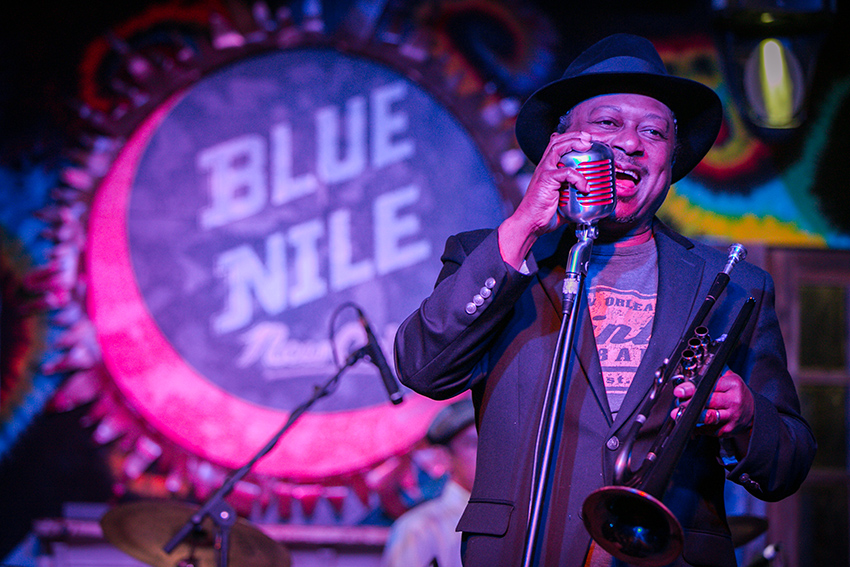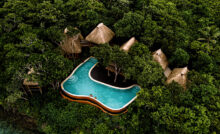Rhythms of a Cultural Haven Immerse yourself in the heartbeat of New Orleans, a haven for music enthusiasts, where jazz, soul, and zydeco thrive alongside the legendary talents of artists like Louis Armstrong. Jazz, born in New Orleans, evolves through global influences, continually transforming and enriching diverse genres


By Rupali Dean
New Orleans was a quintessential melting pot long before it became part of the United States. Under both French and Spanish rule, the city welcomed an influx of refugees from Hispaniola after the Haitian Revolution. With a rich European heritage, New Orleans emerged as North America’s opera capital, hosting U.S. premieres of works by master composers like Rossini and Bellini at the French Opera House. Its strategic position near the Mississippi River facilitated the arrival of paddle steamers laden with cotton, sugar, and other goods, as well as slave ships crossing the Atlantic. The nickname ‘The Big Easy’ arose not from its laid-back nature but due to the plentiful job opportunities it offered. In this vibrant melting pot, diverse cultures and ideas converged.
A CULTURAL MOSAIC
Ellis Marsalis, Kermit Ruffins, Irvin Mayfield, and Troy “Trombone Shorty” Andrews are among the living legends who embody New Orleans’ vibrant jazz scene. Today, brass bands brighten up the streets during Mardi Gras, while the French Quarter’s clubs showcase exceptional live improvisation. The annual Jazz and Heritage Festival highlights the rich evolution of American jazz, reinforcing New Orleans as its mecca. Around 1819, Congo Square became a musical melting pot where enslaved people merged African, Caribbean, and Southern church melodies. Post-Civil War, these influences birthed ragtime and blues, creating a dynamic genre reflective of both joy and sorrow. Blues musicians harnessed wartime trumpets and trombones to echo their sorrows, deepening the emotional resonance of their sound. This fusion with ragtime in the late 1890s birthed a novel American genre—jazz. Syncopation intertwined with soulful melodies, giving rise to a dynamic musical landscape. At the forefront was Buddy Bolden, labelled “the first man of jazz” by historian Donald M. Marquis. Despite no recordings remaining, his improvisational style defined the era until mental health issues derailed his career in 1907. Other jazz stars soon emerged, including Bunk Johnson and Jelly Roll Morton, who, with a touch of enthusiasm, helped shape this vibrant art form. While touring with the Original Creole Orchestra, Freddie Keppard refused an offer from the Victor Talking Machine Company to record the first jazz record in 1915, fearing idea theft. This opened the door for the Original Dixieland Jass Band, under LaRocca, to record in 1917, a move that disheartened many African-American musicians, especially due to LaRocca’s racist claims that jazz was solely a white invention. As historian Ted Gioia noted, it was the migration to Chicago and New York City that propelled musicians to fame. Louis Armstrong, mentored by Joe “King” Oliver, emerged as a pivotal force, transforming jazz into a global phenomenon. Jazz originated here, with icons like Sidney Bechet and Louis Armstrong shaping its essence. The unique Dixieland style, rooted in ragtime, paved the way for new jazz interpretations, as the Big Easy welcomed them all. The New Orleans Jazz Museum in the French Quarter narrates jazz’s rich history, yet the city’s music scene breathes life into that legacy, creating a living narrative.
JAZZ, ALIVE AND UNFOLDING
Jazz funerals, marked by brass bands leading joyous processions, are a cherished tradition. Native American tribes dedicate an entire year to crafting Mardi Gras costumes, parading to vibrant call-and-response rhythms. Gospel brunches invite diners to revel in soul food and uplifting choirs that get everyone dancing. New Orleans enriches rhythm and blues, as seen in the works of Fats Domino, integrating rhythms from Cuban immigrants. The city’s bounce hip-hop style echoes the call-and-response of Mardi Gras Indians, while a unique ‘Louisiana sound’ can even be found in heavy metal.
All of this musical diversity thrives in the city’s venues, particularly on Frenchmen Street, where bars and clubs flow with energy into the early hours. Among them, some venues stand out more than others.
CITY’S HOT SPOTS
Where Opera Meets Elegance
Home to touring Broadway spectacles and the New Orleans Opera, the Mahalia Jackson Theatre boasts a 2,100-seat capacity and upholds the city’s proud title as America’s First City of Opera.
A Sanctuary For Jazz
Nestled in the historic French Quarter, Preservation Hall offers an intimate atmosphere for live jazz, hosting acoustic concerts almost every night since 1961. Originally an art gallery, this family-run institution remains dedicated to preserving the essence of New Orleans jazz.
Melodies And Memories Unite
With its iconic black-and-white floors, Tipitina’s has seen legendary acts like Dr. John and Jane’s Addiction record live albums. This genre-fluid venue spotlights both touring artists and local talent while also inviting guests to partake in Cajun dance sessions influenced by French culture.
Embrace The Brass Vibe
Located on Frenchmen Street, The Blue Nile is known for its diverse line-up—from reggae to funk—but shines brightest with its brass band performances. Expect an energetic atmosphere, especially on weekends, when shows often commence at 11 PM.
THE FESTIVE SPIRIT
Nowhere else does the humble trombone exude such charm as in New Orleans, the birthplace of jazz. While jazz festivals exist globally, none match the swagger of the New Orleans Jazz and Heritage Festival, held annually in late April and early May. This vibrant 10-day celebration centres on jazz but has expanded to feature renowned artists like the Rolling Stones, Queen Latifah, and The Killers at the Fair Grounds Race Course. Amidst performances on smaller stages, food stalls showcase Louisiana cuisine, while arts and crafts booths celebrate local heritage. Jazz Fest proves that the city’s festive spirit goes beyond Mardi Gras. The Big Easy is renowned for its vibrant festival calendar, featuring one-of-a-kind music events. The Essence Music Festival in July celebrates prominent female African-American artists, while the Satchmo Summerfest in August honours the legendary Louis Armstrong. April’s French Quarter Festival enlivens the city’s charming streets with a lively parade and four days of diverse musical genres, accompanied by food stalls showcasing local cuisine.
For a quintessential New Orleans experience, the Oak Street Po’ Boy Festival in November offers creative interpretations of this beloved sandwich, paired with live music. Beyond New Orleans, Baton Rouge and Houma also celebrate their cultures. In April, the Baton Rouge Blues Festival highlights traditional blues against the striking Old State Capitol. Meanwhile, the Rougarou Festival in Houma showcases bayou folklore with spirited costumes and music. The Mudbug Madness Festival in Shreveport focuses on Cajun flavours, and the Breaux Bridge Crawfish Festival presents “crawfish prepared every way imaginable,” attracting 30,000 attendees over three days. The music exudes a genuine sense of place, emphasizing Cajun rock, Zydeco, and swamp pop, accompanied by lively dance competitions and a heritage tent for those interested in exploring Cajun sounds. This unique identity is vital to Louisiana’s festival landscape. Each event provides a unique experience, unlike the usual festivals found elsewhere. Instead, they reflect the vibrant culture and spirited atmosphere of this captivating, culturally rich, and party-ready state.
More from our site
Recent Posts
The PEAKLIFE Regatta 2025
From fashion designer Varoin Marwah’s Coastal Calm SS '25 splash show to a thrilling nautical spin on the sea, it was a magical weekend in Mumbai
From fashion designer Varoin Marwah’s Coastal Calm SS '25 splash show to a thrilling nautical…
Inside Louisiana’s Biggest Festival: 10 Things You Didn’t Know About Mardi Gras
More than a party, Mardi Gras is a cultural phenomenon!
More than a party, Mardi Gras is a cultural phenomenon!
Design Your Dream Home With These Expert Tips
A home that’s stylish, cosy, and truly yours!
A home that’s stylish, cosy, and truly yours!
Luxury in Fiji: Indulge in Paradise
From private island resorts to lavish overwater bungalows, this South Pacific paradise seamlessly blends indulgence with natural beauty
From private island resorts to lavish overwater bungalows, this South Pacific paradise seamlessly blends indulgence…
A Traveller’s Quest: Soorahi
This premium blend whisky brand aims to reflect a spirit of exploration and evolution in India’s alco-beverage landscape
This premium blend whisky brand aims to reflect a spirit of exploration and evolution in…
What’s Buzzing: Fashion, Tech, and Travel Picks You Can’t Miss!
From star-studded fashion collaborations to luxurious getaways and cutting-edge tech, here’s everything making waves this week
From star-studded fashion collaborations to luxurious getaways and cutting-edge tech, here’s everything making waves this…
